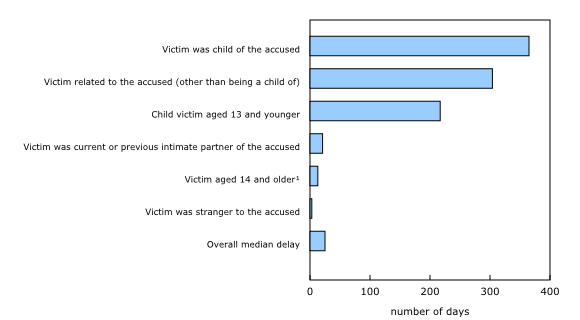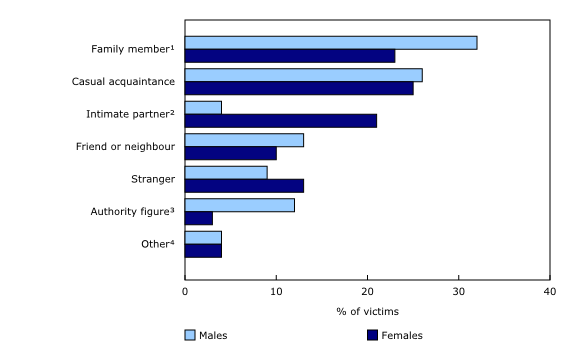Police-reported sexual assaults in Canada, 2009 to 2014: A statistical profile
Archived Content
Information identified as archived is provided for reference, research or recordkeeping purposes. It is not subject to the Government of Canada Web Standards and has not been altered or updated since it was archived. Please "contact us" to request a format other than those available.
Released: 2017-10-03
There were 117,238 sexual assaults reported by police in Canada from 2009 to 2014. The vast majority (98%) of sexual assaults reported by police were level 1 offences, which involve some or no physical injury to the victim. The remaining 2% were level 2 or 3 sexual assaults, which are more violent and involve bodily harm or endangering the life of the victim.
Not all sexual assaults, however, are reported to police. Sexual assault is one of the most underreported crimes in Canada. According to the most recent General Social Survey (GSS) on Canadians' Safety (Victimization), which collects information on incidents whether or not they were reported to the police, about 1 in 20 sexual assaults were reported to the police in 2014. While police-reported data show a 26% drop in sexual assault incidents from 1999 to 2014, the rate of self-reported sexual assaults recorded by the GSS on Victimization has remained consistent over this period.
According to the current GSS on Victimization, the most common reasons for not reporting a sexual assault to police were that the victim felt the crime was minor and not worth taking the time to report (71%); it was handled informally (67%); and no one was harmed (63%). A number of victims voiced concerns regarding the justice system process, including not wanting the hassle of dealing with police (45%); the perception that police would have not considered the sexual assault important enough (43%); and that the offender would not be convicted or adequately punished (40%).
The Juristat article released today, "Police-reported sexual assaults in Canada, 2009 to 2014: A statistical profile," provides information on police-reported sexual assaults and explores incident, victim and accused characteristics. The article focuses on police-reported sexual assaults which include only those incidents that are reported to and substantiated by police and classified by police as founded crimes—that is, where it was determined through police investigation that a crime occurred. For more information on self-reported sexual assaults, refer to the report "Self-reported sexual assault in Canada, 2014."
Majority of sexual assault victims were young females
The majority (87%) of victims of police-reported sexual assault from 2009 to 2014 were female. Overall, young females under the age of 25 accounted for 60% of all police-reported sexual assault victims.
Nearly half (47%) of female victims were under the age of 18, and just over one-fifth (22%) were young women aged 18 to 24. Girls aged 13 and younger accounted for close to one-quarter (23%) of female victims of sexual assault, while nearly one-third (32%) were teenagers aged 14 to 19 years.
Half of male sexual assault victims were boys aged 13 or younger
Males accounted for just over 1 in 10 (13%) victims of police-reported sexual assaults from 2009 to 2014. While the median age of female victims was 18 years, male victims of sexual assault were typically much younger, with a median age of 13 years. Children aged 13 and younger accounted for half (50%) of all male victims of police-reported sexual assault. This highlights a notable difference between the age profile of male and female sexual assault victims, with female victims being largely teenagers or young adults.
Delay in reporting more common among sexual assaults
Of sexual assaults that came to the attention of police, about half (52%) were reported to police on the same day they took place, while the remaining half (48%) were reported some time after. By comparison, the vast majority (88%) of physical assaults were reported to police on the same day as the assault.
Delay in reporting to police about 12 times longer for sexual assault than for physical assault
Among incidents where there was a delay of at least one day between when the crime occurred and when it was reported to police (representing 48% of sexual assault incidents), the median delay in reporting for sexual assault incidents was 25 days. This is about 12 times longer than the median delay in reporting (2 days) for physical assault incidents.
Over one-quarter (28%) of delayed reports of sexual assault were brought to the attention of police more than one year after the incident occurred. The same was true for 2% of physical assaults.
It is important to note that a delay in reporting to police is not necessarily a reflection of the victim choosing to wait to report. Bringing a crime to the attention of police can be done by anyone, including the victim, a parent, a witness, or another individual. Given the young age of many sexual assault victims, this is of particular importance. Child victims may not fully understand their victimization, may be too young to communicate the harms experienced, or be a dependent of the perpetrator.
Sexual assaults involving a child victim saw longest delays in reporting to police
Among incidents where there was a delay of at least one day in reporting to police, victims sexually assaulted by their parent had the longest delay in reporting with a median delay of one year. Overall, regardless of their relationship with their assailant, sexual assaults involving child victims aged 13 or younger saw far longer delays in reporting (median of seven months) than those involving victims aged 14 and older (median of 13 days).
Unlike sexual assaults, physical assault incidents tended to be reported quickly following the incident regardless of the relationship between the victim and the accused.
Research suggests that delays in reporting to police may be related to the psychological and emotional trauma experienced by victims of sexual assault. Coupled with the passage of time, the trauma experienced by the victim may also affect their ability to recall details about the sexual assault.
An examination of police records provided to the Uniform Crime Reporting Survey over the six-year period of study revealed that sexual assaults had at least one unknown element related to the incident or victim in about half (45%) of analyzed incidents, compared with one-fifth (20%) of physical assaults. Specifically, this was measured by having at least one of the following elements reported by police as incomplete or unknown: time of incident, location of incident, presence of weapons, level of physical injury, or relationship between the victim and the accused. The higher prevalence of unknown elements in sexual or physical assault incidents may also be correlated with a delay in reporting of these crimes.
The private nature of sexual assaults can make them more challenging to investigate than physical assaults, given the potential for lack of physical evidence, absence of witnesses, and the sensitivity of the crime for the victim. The combination of delayed reporting and unknown elements about the crime may further contribute to the challenge of investigating sexual assaults relative to physical assaults.
Accused charged in less than half of sexual assault incidents
An accused was identified in 6 out of every 10 (60%) police-reported sexual assault incidents from 2009 to 2014, and was charged in 7 in 10 (69%) of these incidents. Overall, this means that an accused was charged in less than half (41%) of police-reported sexual assaults. By comparison, half (50%) of physical assaults resulted in charges being laid.
Most victims of sexual assault knew their assailant
For just over 1 in 10 (13%) sexual assaults where a charge was laid, the perpetrator was a stranger. The majority (87%) of sexual assault victims knew their assailant, usually as a casual acquaintance (26%), a family member other than a spouse (24%) or an intimate partner (19%). By comparison, physical assaults were most often committed by an intimate partner (58%), while a casual acquaintance (13%) or family member (10%) accounted for a smaller proportion of accused.
Female victims of sexual assault most often knew the accused as a casual acquaintance (25%), a family member (23%) or an intimate partner (21%). Conversely, male victims were more likely than female victims to have been sexually assaulted by a family member (32%), a friend or neighbour (13%), or someone in a position of trust or authority (12%).
Just over half of child sexual assault victims were victimized by a family member
From 2009 to 2014, just over one-quarter (26%) of police-reported sexual assaults involved a child victim aged 13 or younger. Of sexual assaults where a charge was laid, child victims (52%) were three times more likely to have been sexually assaulted by a family member compared with victims aged 14 and older (15%). However, child victims were less likely to have been sexually assaulted by a stranger (5% versus 16%). This represents a stark contrast to sexual assaults involving adult victims, as sexual assaults against children are disproportionately committed by family members and to a much lesser extent by strangers.
Note to readers
Police-reported crimes capture only those incidents that are reported to and substantiated by police as a criminal incident, namely, where it was determined through police investigation that a crime took place. This excludes incidents reported to police that were deemed 'unfounded'. Unfounded incidents have not been collected by Statistics Canada since 2006 due to data quality concerns. Statistics Canada and policing services are working together to develop a common approach for the classification and reporting of unfounded incidents and plan to release first results in July 2018.
This article uses six years of police-reported data (2009 to 2014) from the Uniform Crime Reporting Survey, and includes incidents where a sexual assault (level 1, 2, or 3) was the most serious violation in the incident. Because there can be more than one criminal offence in a single incident, the most serious of these offences is used to represent the incident. This means that sexual assault was the most serious (or the only) offence in the sexual assault incidents analyzed.
Victim and accused data consist of incidents where there was one victim and/or one accused in order to ensure that the characteristics analyzed were accurately measured. Data on accused include only incidents where a charge had been laid. This applies to variables involving both a victim and an accused, such as the age gap or relationship between them.
Accused data were limited to those who had been charged with sexual assault in order to establish a baseline profile for accused eligible to link to a court record. This was done to support a second upcoming Juristat article on the retention of sexual assaults in the criminal justice system, "From arrest to conviction: Court outcomes of police-reported sexual assaults in Canada, 2009 to 2014" (Rotenberg, forthcoming 2017).
It should be noted that by limiting the analysis of the current article to charged accused, a disproportionate number of sexual assaults committed by youth are dropped, given that many youth accused are not charged but are dealt with through alternative or extrajudicial measures as stipulated by the principles set out in the Youth Criminal Justice Act. The forthcoming article will focus on court outcomes of sexual assault and how they differ depending on the circumstances of the incident or the characteristics of the victim or accused.
Products
The Juristat article "Police-reported sexual assaults in Canada, 2009 to 2014: A statistical profile" (85-002-X) is now available.
Contact information
For more information, or to enquire about the concepts, methods or data quality of this release, contact us (toll-free 1-800-263-1136; 514-283-8300; STATCAN.infostats-infostats.STATCAN@canada.ca) or Media Relations (613-951-4636; STATCAN.mediahotline-ligneinfomedias.STATCAN@canada.ca).
- Date modified:



